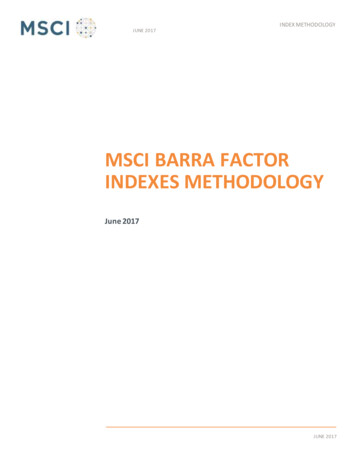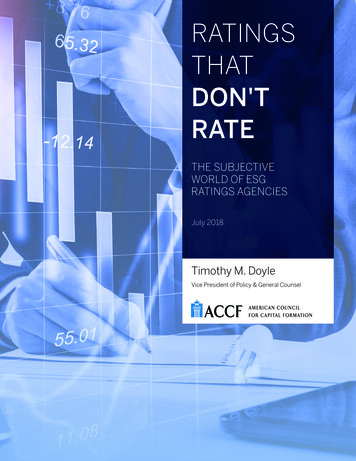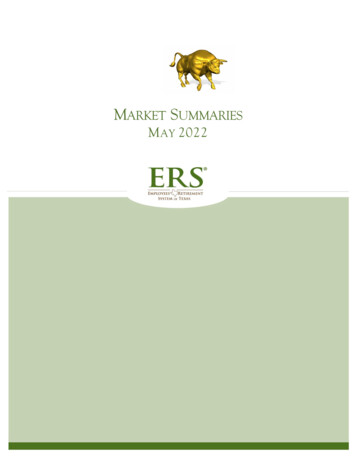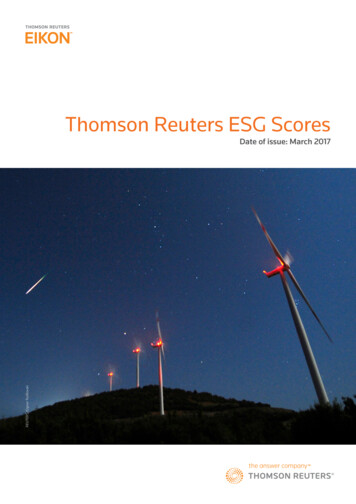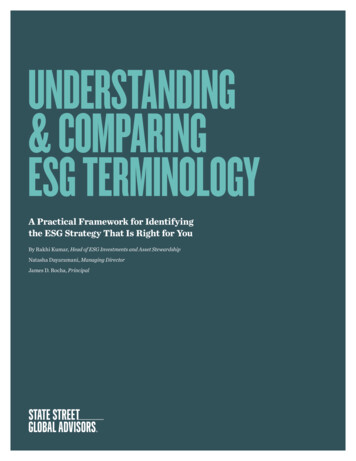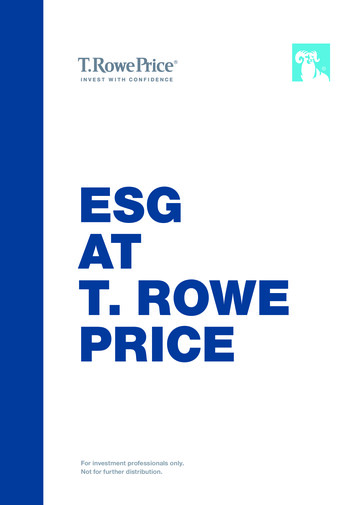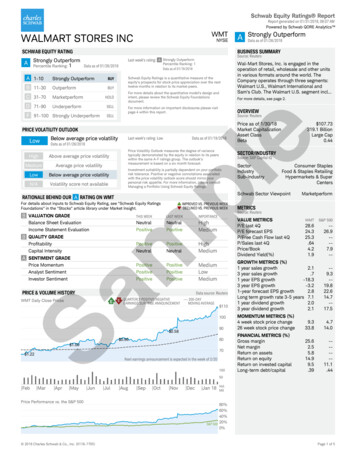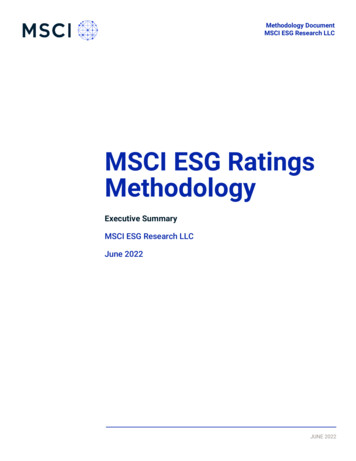
Transcription
Methodology DocumentMSCI ESG Research LLCMSCI ESG RatingsMethodologyExecutive SummaryMSCI ESG Research LLCJune 2022JUNE 2022
MSCI ESG Ratings Methodology June 20221Executive SummaryFrom natural resource scarcity to changing governance standards, from globalworkforce management to the evolving regulatory landscape, ESG factors can affectthe long-term risk-and-return profile of investment portfolios. MSCI ESG Ratings aredesigned to help investors understand ESG risks and opportunities and integrate thesefactors into their portfolio construction and management process.Our global team of over 200 experienced research analysts assesses thousands ofdata points across 35 ESG Key Issues, focusing on the intersection between acompany’s core business and the industry issues that can create significant risksand/or opportunities for a company. Companies are rated on a AAA to CCC scalerelative to the standards and performance of their industry peers.Exhibit 1: ESG Rating Framework and Process OverviewDATA1,000 data points on ESG policies, programs, and performance;Data on 100,000 individual directors; up to 20 years of shareholder meetingresultsEXPOSURE METRICS MANAGEMENT METRICSHow exposed is the companyto each material issue?Based on over 80 businessand geographic segmentmetricsSOURCES100 specialized datasets(government, NGO, models)Company disclosure (10-K,sustainability report, proxy report)3,400 media sources monitoreddaily (global and local newssources, governments, NGOs)MONITORING &QUALITY REVIEWSystematic, ongoing daily monitoring ofcontroversies and governance eventsIn-depth quality review processes at allstages of rating, including formalcommittee reviewHow is the company managingeach material issue?150 policy/program metrics, 20performance metrics;100 Governance Key MetricsKEY ISSUE SCORES &WEIGHTSINSIGHT35 Key Issues selected annually foreach industry and weighted based onMSCI’s materiality mappingframework.Specialized ESG researchteam provides additionalinsight through:ESG RATING (AAACCC)Company reportsIndustry reportsThematic reportsAnalyst calls & webinarsIssue scores and weightscombine to overall ESG ratingrelative to industry peers.IndividualE, S, G scoresalso availableDATA OUTPUTSAccess to selected underlying dataRatings, scores, and weights on680,000 securities17 years of history 2022 MSCI Inc. All rights reserved. Please refer to the disclaimer at the end of this document.MSCI.COM PAGE 2 OF 17
MSCI ESG Ratings Methodology June 20221.1MSCI ESG Ratings Methodology OverviewMSCI ESG Ratings aim to measure a company’s resilience to long-term,financially relevant ESG risks. Of the negative externalities that companies in an industry generate, whichissues may turn into unanticipated costs for companies in the medium to longterm? Conversely, which ESG issues affecting an industry may turn into opportunitiesfor companies in the medium to long-term?More specifically, the MSCI ESG Ratings model seeks to answer four key questionsabout companies: What are the most significant ESG risks and opportunities facing a companyand its industry? How exposed is the company to those key risks and/or opportunities? How well is the company managing key risks and/or opportunities? What is the overall picture of a company and how does it compare to itsglobal industry peers?Material Industry ESG Risks and OpportunitiesEnvironmental, social, and governance risks and opportunities are posed by largescale trends (e.g., climate change, resource scarcity, demographic shifts) as well asby the nature of a company’s operations. Companies in the same industry generallyface the same major risks and opportunities, though individual exposure can vary.The MSCI ESG Ratings model focuses only on issues that are determined as materialfor each industry. A risk is material to an industry when it is likely that companies in agiven industry will incur substantial costs in connection with it (for example: regulatoryban on a key chemical input, thereby requiring reformulation). An opportunity ismaterial to an industry when it is likely that companies in a given industry couldcapitalize on it for profit (for example: opportunities in clean technology for therenewable energy industry).We identify material risks and opportunities for each industry through a quantitativemodel that looks at ranges and average values for each industry for externalizedimpacts such as carbon intensity, water intensity, and injury rates. Companies withunusual business models for their industry may face fewer or additional key risks andopportunities. Company-specific exceptions are allowed for companies with 2022 MSCI Inc. All rights reserved. Please refer to the disclaimer at the end of this document.MSCI.COM PAGE 3 OF 17
MSCI ESG Ratings Methodology June 2022diversified business models, facing controversies, or based on industry rules. Onceidentified, these Key Issues are assigned to each industry and company.Exhibit 2: MSCI ESG Key Issue Hierarchy3 Pillars10 Themes35 ESG Key IssuesEnvironmentClimate ChangeCarbon EmissionsFinancing Environmental ImpactProduct Carbon FootprintClimate Change VulnerabilityWater StressRaw Material SourcingNatural CapitalBiodiversity & Land UseSocialPollution &WasteToxic Emissions & WasteEnvironmentalOpportunitiesOpportunities in Clean TechOpportunities in Green BuildingOpportunities in RenewableEnergyHuman CapitalLabor ManagementHuman Capital DevelopmentHealth & SafetySupply Chain Labor StandardsProduct Safety & QualityPrivacy & Data SecurityChemical SafetyResponsible InvestmentConsumer Financial ProtectionHealth & Demographic RiskProduct LiabilityGovernanceElectronic WastePackaging Material & WasteStakeholderOppositionControversial SourcingSocialOpportunitiesAccess to CommunicationsAccess to Health CareAccess to FinanceOpportunities in Nutrition &HealthCorporateGovernanceOwnership & ControlPayBoardAccountingCorporateBehaviorBusiness EthicsCommunity RelationsTax TransparencyESG RatingsTo arrive at a final ESG Rating, the weighted average of individual Environmental andSocial Key Issue Scores and the Governance Pillar Score is calculated and thennormalized relative to ESG Rating industry peers. After any committee-level overridesare factored in, each company’s Final Industry-Adjusted Score corresponds to arating between best (AAA) and worst (CCC). These assessments are not absolutebut are explicitly intended to be interpreted relative to a company’s industry peers. 2022 MSCI Inc. All rights reserved. Please refer to the disclaimer at the end of this document.MSCI.COM PAGE 4 OF 17
MSCI ESG Ratings Methodology June 2022Setting Key Issue WeightsOnce the Key Issues have been selected for a Global Industry Classification Standard(GICS) sub-industry1, we set the weights that determine the contribution to the overallrating of: each Key Issue in the Environmental and Social Pillars; and the Governance Pillar.Environmental and Social Key IssuesEach Environmental and Social Key Issue typically comprises 5% to 30% of the totalESG Rating. The weightings consider the contribution of the industry, relative to allother industries, to both the negative or positive impact on the environment or society;and the timeline within which we expect that risk or opportunity to materialize forcompanies in the industry, as illustrated conceptually below.Exhibit 3: Framework for Setting Key Issue WeightsExpected Time frame forRisk/Opportunity to MaterializeShort-Term( 2 years)Level ofContribution toEnvironmental orSocial ImpactIndustry is majorcontributor to impactLong-Term(5 years)Highest WeightIndustry is minorcontributor to impactLowest WeightThe framework is such that a Key Issue defined as “High-Impact” and “Short-Term”would be weighted three times higher than a Key Issue defined as “Low-Impact” and“Long-Term.” Level of contribution to social or environmental externality: Like the processoutlined above, each GICS sub-industry is assigned a “High,” “Medium,” or“Low” impact for each Key Issue, based on our analysis of relevant data (e.g.,average carbon emissions intensity).1The Global Industry Classification Standard (GICS) was developed by and is the exclusive property of MSCI and Standard& Poor’s. “Global Industry Classification Standard (GICS )” is a service mark of MSCI and Standard & Poor’s. 2022 MSCI Inc. All rights reserved. Please refer to the disclaimer at the end of this document.MSCI.COM PAGE 5 OF 17
MSCI ESG Ratings Methodology June 2022 Expected time horizon of risk/opportunity: The time horizon of each Key Issue(Short-Term, Medium-Term, Long-Term) is classified based on the type of riskor opportunity that each Key Issue presents to companies.Governance Pillar WeightSince November 2020, the Governance Pillar weight has been determined for allGICS sub-industries assuming a “High Contribution/Long Term” and “MediumContribution/Long Term” assessment on Corporate Governance and CorporateBehavior, respectively.2 Additionally, the weight on the Governance Pillar is floored ata minimum value of 33%.Key Issue AssessmentRisksTo understand whether a company is adequately managing a key ESG risk, it isessential to understand both what management strategies it has employed and howexposed it is to the risk. The MSCI ESG Ratings model measures both of these: riskexposure and risk management.To score well on a Key Issue, management needs to be commensurate with the levelof exposure: a company with high exposure must also have very strongmanagement, whereas a company with limited exposure can have a more modestapproach. Conversely, a highly exposed company with poor management will scoreworse than a company with the same management practices but lower exposure tothe risk.Example: Electric Utilities are typically highly water-dependent, but eachcompany may be more or less exposed to water-related risks depending onwhere its facilities are – desert locations present much higher risks thanthose where water supplies are plentiful. Companies operating in waterscarce regions must take more extensive measures to mitigate these risksthan those with abundant access to water.While Key Issues are identified by looking quantitatively at each industry as a whole,individual companies’ exposure to each issue will vary. MSCI ESG Ratings determineeach company’s exposure to key ESG risks based on a granular breakdown of itsbusiness: its core product or business segments, the locations of its operations, andother relevant measures such as outsourced production or reliance on governmentcontracts. Risk exposure is scored on a 0-10 scale, with 0 representing no exposure2In cases where the Corporate Governance score cannot be calculated for the Governance Reference Entity due toinsufficient disclosure, the Governance Pillar score is calculated solely by reference to the Corporate Behavior Key Issue. 2022 MSCI Inc. All rights reserved. Please refer to the disclaimer at the end of this document.MSCI.COM PAGE 6 OF 17
MSCI ESG Ratings Methodology June 2022and 10 representing very high exposure. The rating then considers the extent towhich a company has developed strategies and demonstrated a strong track recordof performance in managing its specific level of risks or opportunities.Ongoing controversies or those that have occurred within the last three years lead toa deduction from the overall management score on each impacted issue.Management is scored on a 0-10 scale, where 0 represents no evidence ofmanagement efforts and 10 represents indicates very strong management.Exhibit 4: Combining Exposure and Management – ‘Risk’ Key Issues1098Management Score76543210012345678910Exposure Score𝑲𝒆𝒚 𝑰𝒔𝒔𝒖𝒆 𝑺𝒄𝒐𝒓𝒆 𝟕 (𝑴𝑨𝑿(𝒆𝒙𝒑𝒐𝒔𝒖𝒓𝒆, 𝟐) ned 0-10, rounded to one decimal)The Risk Exposure Score and Risk Management Score are combined such that ahigher level of exposure requires a higher level of demonstrated managementcapability in order to achieve the same overall Key Issue Score. Key Issue scores arealso on a 0-10 scale, where 0 is very poor and 10 is very good. The example below 2022 MSCI Inc. All rights reserved. Please refer to the disclaimer at the end of this document.MSCI.COM PAGE 7 OF 17
MSCI ESG Ratings Methodology June 2022outlines how the interplay between risk exposure and management differs for autility focused on conventional power generation compared with a utility which islargely focused on electricity transmission and distribution.Example: Utility Company A focuses on conventional power generation,which typically results in large carbon and toxic emissions. It has high riskexposure in these areas. To score well on these issues, it must have strongrisk mitigation programs in place. Utility Company B is largely focused onelectricity transmission and distribution, which are lower polluting activities.Although they are in the same industry, Company A and Company B havedifferent levels of exposure to these risks. Company B can score as well asCompany A with more modest risk mitigation efforts. Alternatively, ifCompany B has risk mitigation efforts similar to company A, it will scorehigher overall because its risk management is stronger relative to its riskexposure.OpportunitiesAssessment of opportunities works similarly to risks, but the model for combiningexposure and management differs. Exposure indicates the relevance of theopportunity to a given company based on its current business and geographicsegments. Management indicates the company’s capacity to take advantage of theopportunity. Where exposure is limited, the Key Issue score is constrained toward themiddle of the 0-10 range, while high exposure allows for both higher and lowerscores. 2022 MSCI Inc. All rights reserved. Please refer to the disclaimer at the end of this document.MSCI.COM PAGE 8 OF 17
MSCI ESG Ratings Methodology June 2022Exhibit 5: Combining Exposure and Management – ‘Opportunities’ Key IssuesControversiesMSCI ESG Ratings include controversies, which may indicate structural problemswith a company’s risk management capabilities. In the ESG Rating model, acontroversy case that is deemed by an analyst to indicate structural problems thatcould pose future material risks for the company triggers a larger deduction from theKey Issue score than a controversies case that is deemed to be an importantindicator of recent performance but not a clear signal of future material risk.A controversy case is defined as an instance or ongoing situation in which companyoperations and/or products allegedly have a negative environmental, social, and/orgovernance impact. A case is typically a single event such as a spill, accident,regulatory action, or a set of closely linked events or allegations such as health andsafety fines at the same facility, multiple allegations of anti-competitive behaviorrelated to the same product line, multiple community protests at the same companylocation, or multiple individual lawsuits alleging the same type of discrimination.Each controversy case is assessed for the severity of its impact on society or theenvironment and consequently rated Very Severe (reserved for ‘worst of the worst’cases), Severe, Moderate, or Minor. 2022 MSCI Inc. All rights reserved. Please refer to the disclaimer at the end of this document.MSCI.COM PAGE 9 OF 17
MSCI ESG Ratings Methodology June 2022Exhibit 6: Assessment of Controversial CasesNature of ImpactScale of ImpactEgregiousSeriousMediumMinimalExtremely WidespreadVery SevereSevereSevereModerateExtensiveVery inorMinorLowModerateModerateMinorMinorDetermining Governance ScoresThe Governance Pillar Score is an absolute assessment of a company’s governancethat uses a universally applied 0-10 scale.Each of the Governance Pillar Scores, the Theme Scores and the Key Issue Scoresare independently calculated based on a deduction-based approach in which pointsare deducted from a “perfect 10” based on the triggering of Key Metrics across theunderlying Key Issues.Exhibit 7: Governance Model StructureConstructing the RatingThe ESG Ratings model is industry relative and uses a weighted average approach. 2022 MSCI Inc. All rights reserved. Please refer to the disclaimer at the end of this document.MSCI.COM PAGE 10 OF 17
MSCI ESG Ratings Methodology June 2022In the Environmental and Social pillars, Key Issue weights are determined for eachGICS sub-industry based on the sub-industry's contribution to the negative externalityassociated with the Key Issue and the expected time horizon for the Key Issue tomaterialize. Key Issues and weights undergo a formal review and feedback process atthe end of each calendar year. For the Governance pillar, the weight is set at the pillarlevel rather than at the Key Issue level.Company-specific Key Issues and weights are permitted, subject to committeeapproval, for companies with diversified business models, facing controversies orbased on pre-defined industry rules.For each company a Weighted Average Key Issue Score is calculated based on theunderlying Pillar scores and weights: The Environmental and Social Pillar Scores are derived from the weightedaverage of underlying Key Issue scores. The Governance Pillar Score is calculated using a deduction-based approach.Each company receives an Industry-Adjusted Score (IAS), which is defined by theweighted average of the Environmental and Social Key Issue Scores and theGovernance Pillar Score and normalized based on score ranges set by benchmarkvalues in the peer set.The following criteria apply in setting the industry top and bottom benchmark values: The top benchmark value (“industry maximum score”) falls between the 95thand 100th percentile of modeled weighted average key issue scores (WAKIS)within an ESG Rating Industry. The bottom benchmark value (“industry minimum score”) falls between the0th and 5th percentile of modeled weighted average key issue scores(WAKIS) within an ESG Rating Industry.Percentiles were calculated based on the full universe of companies with ESG Ratings( 9,800 companies).The Industry Adjusted Score corresponds to a rating between best (AAA) and worst(CCC). These assessments of company performance are not absolute but areexplicitly intended to be relative to the standards and performance of a company’sindustry peers. 2022 MSCI Inc. All rights reserved. Please refer to the disclaimer at the end of this document.MSCI.COM PAGE 11 OF 17
MSCI ESG Ratings Methodology June 2022Exhibit 8: Mapping the Industry Adjusted Company Score to Letter RatingsLetter RatingLeader/LaggardFinal Industry-Adjusted Company ScoreAAALeader8.571* - 10.0AALeader7.143 – 8.571AAverage5.714 – 7.143BBBAverage4.286 – 5.714BBAverage2.857 – 4.286BLaggard1.429 – 2.857CCCLaggard0.0 – 1.429*Appearance of overlap in the score ranges is due to rounding imprecisions. The 0-to-10scale is divided into seven equal parts, each corresponding to a letter rating.MSCI ESG Research recalibrates these benchmark values on an annual basis toreflect changes to underlying company data, methodology updates and fluctuationsin industry peer sets. 2022 MSCI Inc. All rights reserved. Please refer to the disclaimer at the end of this document.MSCI.COM PAGE 12 OF 17
MSCI ESG Ratings Methodology June 2022Exhibit 9: Hierarchy of ESG ScoresESG Letter Rating(AAA-CCC)Pre-set score-to-letter-rating matrixFinal IndustryAdjusted Score (0-10)Adjusted relative to Industry Peers, Exceptional overridesWeighted Average KeyIssue Score (0-10)Weighted average of underlying pillar scoresEnvironment PillarScore (0-10)Social PillarScore (0-10)Governance PillarScore (0-10)Each pillar is organized into underlying themes;Environmental and Social Pillar and Theme Scores derive fromthe weighted average of underlying Issue scoresEnvironmental KeyIssue Scores (0-10)Social Key IssueScores atorsStrategyPrograms yPrograms d scoringmodel appliedGovernance Key IssueScores (0-10)Key Metric DeductionsKey Metrics:Ownership Characteristics;Board & CommitteeComposition;Pay Figures;Accounting Metrics;Policies & PracticesBusiness & GeographicSegments; ControversiesRaw DataCompany financial and sustainability disclosure, specialized government & academic data sets, media searches, etc. 2022 MSCI Inc. All rights reserved. Please refer to the disclaimer at the end of this document.MSCI.COM PAGE 13 OF 17
MSCI ESG Ratings Methodology June 20221.2ESG Ratings Process OverviewData SourcesTo assess companies’ exposure to and management of ESG risks and opportunities,we collect data from the following sources: Macro data at segment or geographic level from academic, government,NGO datasets (e.g., Transparency International, US EPA, World Bank) Company disclosure (10-K, sustainability report, proxy report, AGM results,etc.) Government databases, 3,400 media, NGO, other stakeholder sourcesregarding specific companies.Issuer Communications and Feedback ProcessWe proactively reach out to companies as part of our standardized and systematicdata review processes. We do not issue surveys or questionnaires or conduct generalinterviews with companies, nor do we accept or consider in our analysis any dataprovided by issuers that is not publicly available to other stakeholders. Being mindfulof the “survey fatigue” faced by issuers, we make efforts not to overburden companieswith data review requests.Typically, companies receive an alert when the ESG Rating review is complete. Giventhe dynamic nature of our research, companies can access the data we have collectedto date via the issuer portal at any time to review. They are welcome to ask questionsand provide feedback at any time.We are committed to updating a company profile as required in a timely manner. Thisprocess is also in accordance with the objective of frequently updating companyreports with the latest available information as provided by companies. Please notethat updates to ESG data will not necessarily result in changes to a company’s ESGrating.For more information on how we interact with companies, please see the ESG IssuerCommunications FAQ.Monitoring and UpdatesCompanies are monitored on a systematic and ongoing basis, including dailymonitoring of controversies and governance events. New information is reflected inreports on a weekly basis and significant changes to scores trigger analyst review andre-rating. Companies typically receive an in-depth review on an annual basis. 2022 MSCI Inc. All rights reserved. Please refer to the disclaimer at the end of this document.MSCI.COM PAGE 14 OF 17
MSCI ESG Ratings Methodology June 2022Quality ReviewFormal in-depth quality-review processes take place at each stage of analysis,including automated and quality checks of data and rating publication; industry- andmarket-lead oversight of ratings and reports; and ESG Ratings MethodologyCommittee approval of any exceptions, rating overrides or major (2 ) rating changes.The ESG Methodology Committee reviews contentious cases and model changes.Annual ConsultationMSCI ESG Research typically conducts an annual review of the Key Issues assignedto each industry as well as their weights. This process may also identify emergingissues and those that have become less significant. As part of this process, MSCI ESGResearch consults with clients about proposed changes to Key Issue selections foreach industry as well as any proposed new Key Issues.Changes Resulting from Exceptional CircumstancesIn addition to changes resulting from the annual consultation or other business-asusual methodology changes and enhancements, in certain instances, such as due toan extraordinary event or unanticipated or exceptional circumstances, MSCI ESGResearch may determine that it is necessary to change the ESG Ratings methodologyor apply score adjustments for specific markets, industries or companies. Thesedeterminations are made by the ESG Methodology Committee in order to better reflectthe status of an affected market, industry or company when the methodology doesnot otherwise contemplate or capture the impact of the significant event orcircumstance. For example, such events or circumstances could include, but are notlimited to, significant geopolitical conflicts, market upheaval, or force majeure orsimilar events that limit or reduce access to relevant or reliable input data. MSCI ESGResearch will inform clients in the event of any such change or adjustment and theplanned implementation timing and method.1.3CoverageFor details regarding our current ESG Ratings coverage, please visit the ESG Ratingssection on MSCI.com.Additions to the MSCI ACWI Index and the MSCI US Investable Market Index (IMI) aretypically rated within one quarter from their addition to the relevant index, while othercompanies are rated within two quarters from their addition to the relevant index. 2022 MSCI Inc. All rights reserved. Please refer to the disclaimer at the end of this document.MSCI.COM PAGE 15 OF 17
MSCI ESG Ratings Methodology June 2022Contact BostonChicagoMonterreyNew YorkSan FranciscoSão PauloToronto1 888 588 4567 * 1 404 551 3212 1 617 532 0920 1 312 675 0545 52 81 1253 4020 1 212 804 3901 1 415 836 8800 55 11 3706 1360 1 416 628 1007EUROPE, MIDDLE EAST & AFRICACape TownFrankfurtGenevaLondonMilanParis 27 21 673 0100 49 69 133 859 00 41 22 817 9777 44 20 7618 2222 39 02 5849 04150800 91 59 17 *ASIA PACIFICChina NorthChina SouthHong 0800 852 1032 *10800 152 1032 * 852 2844 9333 91 22 6784 916000798 8521 3392 *800 852 3749 * 61 2 9033 9333008 0112 7513 *0018 0015 6207 7181 * 81 3 5290 1555About MSCIMSCI is a leading provider of criticaldecision support tools and services forthe global investment community. Withover 50 years of expertise in research,data and technology, we power betterinvestment decisions by enabling clientsto understand and analyze key drivers ofrisk and return and confidently buildmore effective portfolios. We createindustry-leading research-enhancedsolutions that clients use to gain insightinto and improve transparency acrossthe investment process.About MSCI ESG Research Productsand ServicesMSCI ESG Research products andservices are provided by MSCI ESGResearch LLC, and are designed toprovide in-depth research, ratings andanalysis of environmental, social andgovernance-related business practicesto companies worldwide. ESG ratings,data and analysis from MSCI ESGResearch LLC. are also used in theconstruction of the MSCI ESG Indexes.MSCI ESG Research LLC is a RegisteredInvestment Adviser under theInvestment Advisers Act of 1940 and asubsidiary of MSCI Inc.To learn more, please visitwww.msci.com.* toll free 2022 MSCI Inc. All rights reserved.MSCI.COM PAGE 16 OF 17
MSCI ESG Ratings Methodology June 2022Notice and disclaimerThis document and all of the information contained in it, including without limitation all text, data, graphs, charts (collectively, the “Information”) is the property of MSCI Inc. or its subsidiaries(collectively, “MSCI”), or MSCI’s licensors, direct or indirect suppliers or any third party involved in making or compiling any Information (collectively, with MSCI, the “Information Providers”)and is provided for informational purposes only. The Information may not be modified, reverse-engineered, reproduced or redisseminated in whole or in part without prior written permissionfrom MSCI. All rights in the Information are reserved by MSCI and/or its Information Providers.The Information may not be used to create derivative works or to verify or correct other data or information. For example (but without limitation), the Information may not be used to createindexes, databases, risk models, analytics, software, or in connection with the issuing, offering, sponsoring, managing or marketing of any securities, portfolios, financial products or otherinvestment vehicles utilizing or based on, linked to, tracking or otherwise derived from the Information or any other MSCI data, information, products or services.The user of the Information assumes the entire risk of any use it may make or permit to be made of the Information. NONE OF THE INFORMATION PROVIDERS MAKES ANY EXPRESS ORIMPLIED WARRANTIES OR REPRESENTATIONS WITH RESPECT TO THE INFORMATION (OR THE RESULTS TO BE OBTAINED BY THE USE THEREOF), AND TO THE MAXIMUM EXTENTPERMITTED BY APPLICABLE LAW, EACH INFORMATION PROVIDER EXPRESSLY DISCLAIMS ALL IMPLIED WARRANTIES (INCLUDING, WITHOUT LIMITATION, ANY IMPLIED WARRANTIESOF ORIGINALITY, ACCURACY, TIMELINESS, NON-INFRINGEMENT, COMPLETENESS, MERCHANTABILITY AND FITNESS FOR A PARTICULAR PURPOSE) WITH RESPECT TO ANY OF THEINFORMATION.Without limiting any of the foregoing and to the maximum extent permitted by applicable law, in no event shall any Information Provider have any liability regarding any of the Informationfor any direct, indirect, special, punitive, consequential (including lost profits) or any other damages even if notified of the possibility of such damages. The foregoing shall not exclude orlimit any liability that may not by applicable law be excluded or limited, including without limitation (as applicable), any liability for death or personal injury to the extent that such injuryresults from the negligence or willful default of itself, its servants, agents or sub-contractors.Information containing any historical information, data or analysis should not be taken as an indication or guarantee of any future performance, analysis, forecast or prediction. Pastperformance does not guarantee future results.The Information should not be relied on and is not a s
exposed it is to the risk. The MSCI ESG Ratings model measures both of these: risk exposure and risk management. To score well on a Key Issue, management needs to be commensurate with the level of exposure: a company with high exposure must also have very strong management, whereas a company with limited exposure can have a more modest approach.


